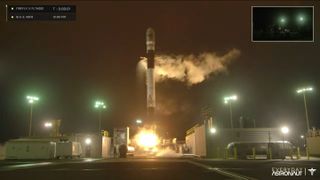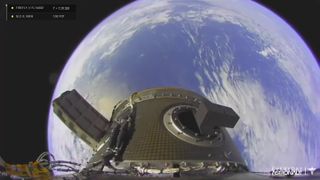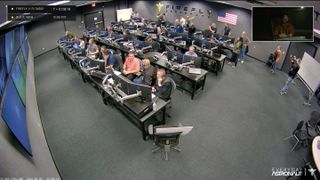A new rocket just earned its wings.
Firefly Aerospace's Alpha rocket aced a test flight today (Oct. 1), successfully delivering a handful of tiny satellites to Earth orbit for the first time ever.
The 95-foot-tall (29 meters) rocket lifted off from California's Vandenberg Space Force Base today at 3:01 a.m. EDT (12:01 a.m. local California time; 0701 GMT), kicking off a demonstration mission that Firefly called "Alpha Flight 2: To The Black."
Video: Watch Firefly Aerospace use a rocket engine to light birthday candles

As that name indicates, it was the second orbital launch for Alpha. During the first, a test flight from Vandenberg in September 2021, one of the rocket's four first-stage Reaver engines shut down prematurely, leading to the loss of the mission.
Things went better today; Alpha climbed into the California sky smoothly and hit its marks as planned. The rocket's two stages separated about 2.5 minutes after liftoff, and the upper stage inserted into an elliptical transfer orbit five minutes after that.
The upper stage performed a brief circularization burn with its single Lightning engine about 53 minutes after launch, maneuvering itself into an orbit targeted to be 190 miles (300 kilometers) above Earth.
Get the Space.com Newsletter
Breaking space news, the latest updates on rocket launches, skywatching events and more!
The mission plan called for all three payloads to be deployed just under an hour after liftoff. That did indeed happen, Tim Dodd of EverydayAstronaut.com said during his webcast of the today's launch, citing conversations with Firefly personnel. (Alpha's upper stage was not in communication with a ground station when deployment occurred, so news of this success did not come in real time.)

🚀 Alpha has reached orbit! FLTA002 has gone #ToTheBlackOctober 1, 2022
All three payloads are tiny, each about the size of a loaf of bread. One of them, called Serenity, comes from the nonprofit organization Teachers in Space. Serenity was designed to collect a variety of data during today's flight, which will be shared with the educational community, according to a Firefly mission description.
Also reaching orbit today was TechEdSat-15 (TES-15), which is owned by NASA in coordination with San Jose State University in California. TES-15 features an "exo-brake" designed to help satellites leave their orbital perches more smoothly when their work is done.
"The exo-brake will deploy after the cubesat is ejected from its dispenser to deorbit the cubesat," Firefly wrote in the mission description. TES-15 also carries an experiment designed to optimize data transfer from the little spacecraft, the company added.
The third payload — the PicoBus deployer, from the nonprofit Libre Space — carries five tiny payloads of its own. Those bantam "picosats" include Genesis-L & Genesis-N, from AMSAT (Radio Amateur Satellite Corporation) Spain. The pair will demonstrate a pulsed-plasma thruster system for spacecraft propulsion and "build heritage for future missions," according to Firefly.
PicoBus is also carrying Libre Space's Qubik-1 and Qubik-2, which will perform communications experiments, and FossaSat-1B. This latter satellite, from the Spanish company Fossa Systems, will test communications and remote-sensing tech. It also carries a low-resolution Earth-imaging camera.

The expendable Alpha is designed to give small satellites dedicated rides to orbit. The rocket can deliver 2,580 pounds (1,170 kilograms) of payload to low Earth orbit for $15 million per launch, according to Firefly's Alpha user's guide.
Firefly wants Alpha to be a leading option in the small-satellite launch industry, an increasingly competitive space that features players such as Rocket Lab and Virgin Orbit (which both offer smallsats dedicated rides) and SpaceX (which sells "rideshare" spots on its larger, more powerful Falcon 9 rocket).
Today's test flight was originally supposed to launch on Sept. 11, but Firefly scrubbed that attempt due to an unexpected drop in helium pressure. Unfavorable weather forecasts then pushed the mission to Sept. 30; an attempt on that day was aborted just after engine ignition, delaying the launch by an additional day.
Mike Wall is the author of "Out There" (Grand Central Publishing, 2018; illustrated by Karl Tate), a book about the search for alien life. Follow him on Twitter @michaeldwall. Follow us on Twitter @Spacedotcom or on Facebook.
Join our Space Forums to keep talking space on the latest missions, night sky and more! And if you have a news tip, correction or comment, let us know at: community@space.com.

Michael Wall is a Senior Space Writer with Space.com and joined the team in 2010. He primarily covers exoplanets, spaceflight and military space, but has been known to dabble in the space art beat. His book about the search for alien life, "Out There," was published on Nov. 13, 2018. Before becoming a science writer, Michael worked as a herpetologist and wildlife biologist. He has a Ph.D. in evolutionary biology from the University of Sydney, Australia, a bachelor's degree from the University of Arizona, and a graduate certificate in science writing from the University of California, Santa Cruz. To find out what his latest project is, you can follow Michael on Twitter.
